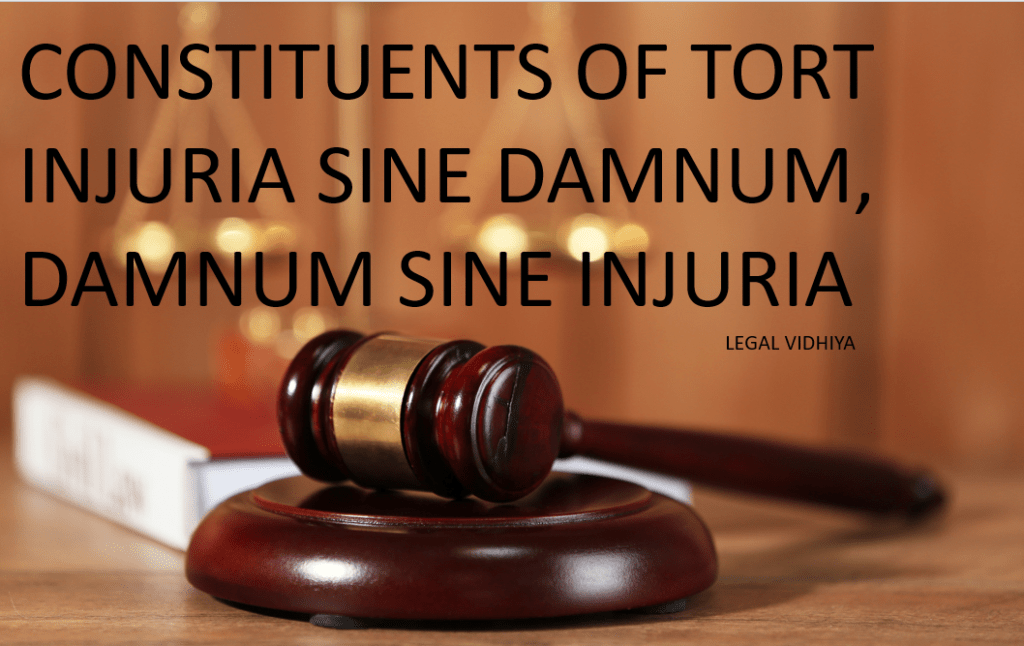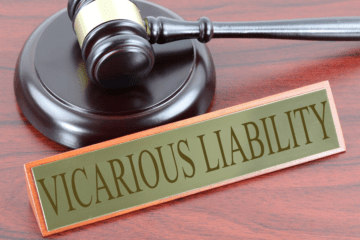
This article is written by Nammrta Singh of LLM of 1st Semester of Chandigarh University, an intern under Legal Vidhiya
Abstract:
The legal doctrines of “injuria sine damno” and “damnum sine injuria” are essential concepts in tort law that address the complex relationship between harm and legal wrongs. “Injuria sine damno” signifies a legal injury without actual damage, wherein a plaintiff’s rights are violated, but no tangible harm or loss is suffered. On the other hand, “damnum sine injuria” refers to a situation where a plaintiff incurs harm or loss without a corresponding legal injury. This abstract explores the nuances of these doctrines, discussing their historical evolution, the role they play in tort law, and their contemporary relevance in the context of evolving legal principles. Understanding the distinction between these concepts is vital in assessing and addressing grievances in the legal system, as it helps maintain a balance between individual rights and societal interests while seeking to achieve justice and fairness.
These doctrines serve as guiding principles in tort law, aiding in the assessment of cases involving injury and loss. The interplay between legal injury and financial damage forms a critical axis in determining the legitimacy of claims, highlighting the nuanced relationship between the violation of rights and the consequential financial repercussions. Understanding and applying these doctrines are pivotal in adjudicating cases where harm, injury, and loss intertwine within the intricate fabric of the legal system.
Introduction
Tort law is a vital component of the legal system, serving to address harms and provide remedies for individuals who have suffered injury or damage due to the wrongful actions of others.Tort law encompasses a wide range of legal principles and rules that govern personal injury, property damage, and economic loss claims. These claims, known as torts, can be categorized into two main types: damnum sine injuria and injuria sine damnum.
Damnum sine injuria refers to a situation where there is actual damage suffered by the plaintiff, but no legal wrong has been committed.
Injuria sine damno” and “damnum sine injuria” are two essential legal concepts that delve into the realm of tort law, addressing the complexities of harm and injury in legal contexts.
“Injuria sine damno” refers to a situation where there’s an injury caused without any actual monetary loss or damage suffered by the plaintiff. In simpler terms, it deals with instances where a legal injury occurs, even if there is no financial harm. This concept emphasizes that a person can claim damages for an injury to their legal rights, regardless of whether any direct loss or financial damage has been incurred.
On the other hand, “damnum sine injuria” focuses on scenarios where there is actual damage or monetary loss suffered by the plaintiff, but there is no legal injury. In essence, it denotes a situation where harm or loss has been caused, yet there hasn’t been any infringement upon the legal rights of the individual. Therefore, despite the financial loss, there might not be a legal basis for claiming compensation.
Understanding these concepts is pivotal in evaluating cases involving legal injury and financial loss. They form the foundation for determining the validity of claims in tort law, where the presence or absence of either legal injury or financial loss significantly influences the outcome of legal proceedings.
Injuria Sine Damnum
This maxim is the opposite of the previously stated maxim. It refers to harm without recourse. This maxim states that even the smallest legal injury, even if it has no effect on the plaintiff’s legal damages, is entitled to adequate compensation, whether it be nominal, punitive, or exemplary. Everybody has the right to certain fundamental liberties, whether they are guaranteed by statute or the constitution, and they should be able to exercise them without interference.
Any violation of these rights is subject to compensation under tort law in the form of various types of damages or restitution.
The amount of damages is determined by a number of factors, including the degree of the legal harm sustained, the type of right violated, the plaintiff-defendant relationship, the amount of harm anticipated by the defendant, the defendant’s efforts to mitigate the harm, and more.
- Nominal Damages
These are the compensation granted to the plaintiff in cases where the plaintiff suffered very little or no harm. Even though Re. 1 is a small amount of damages, the courts award it because the principle of Injuria sine Damnum compels them to acknowledge any harm, no matter how minor, that the plaintiff’s rights have been violated.
Holt, C. J. is most known for having emphasized the significance of nominal damages.
Even though it only costs him a small amount of money—just a little diachylon—if a man gives another person a cuff on his ear, he will still be held accountable for the other person riding over his property even though it did not cause him any harm because it is an invasion of his property and the other person’s.[1]
- Contempus Damages
The courts grant these damages when they determine that even though the plaintiff’s legal rights have been infringed, he has not actually appeared in court with clean hands. When a petitioner’s legal rights are violated, he or she is in the wrong. In this instance, the plaintiff has a legal right to damages, and the court recognizes that right, even though the plaintiff’s wrongdoing has significantly diminished the amount of damages awarded. The petitioner’s meager award serves as evidence of the court’s contempt for the plaintiff’s initial offense.
- Enhanced losses
These damages are granted in recognition of the plaintiff’s extraordinary harm or damage as a result of the defendant’s actions. For instance, the court may grant aggravated damages if the defendant intentionally played loud music to annoy the plaintiff, who may be hard of hearing due to age or other illness.
As opposed to a regular man who can only seek compensatory damages, a football player who fell into a deep pit and hurt his leg may be awarded aggravated damages in recognition of the harm done to his athletic career.
Case Laws related to Injuria sine damnum
Municipal Corporation of Agra v. Asharfilal[2]
This case bears similarities to Ashby v. White, a British case. Here, a voter’s name was removed from the local municipality election ballot, depriving him of the opportunity to exercise his constitutional right to vote. As a result, he filed a damages lawsuit against the Municipal Corporation of Agra, claiming that his legal rights had been violated and seeking restitution. Citing the Ashby v. White ruling, the court granted the appellant nominal damages.
Bhim Singh versus the Jammu & Kashmir StateReference [14]
Bhim Singh was an MLA for the Jammu Kashmir State Legislative Assembly when he was detained by the state police for an illegal detention period that exceeded what was reasonable while he was traveling to attend a legislative assembly vote.
His wife filed a habeas corpus plea to get him released from his deception. The MLA was not brought before the magistrate within a reasonable amount of time following his arrest, and the police had obtained the arrest orders in secret, which called for a thorough investigation and suggested that they were working with opposing political parties.
The Supreme Court awarded compensatory damages of Rs. 50,000 to MLA Bhim Singh in recognition of his democratic right. Additionally, the concerned police officers received criticism for their dishonest behavior and failure to fulfill their legal obligations.[3]
Damnum Sine Injuria
Summa sine Damage without a legal injury is called injuria. It basically describes circumstances in which an individual or organization experiences injury or loss, but their legal rights have not been violated. A legitimate legal claim typically requires proof of both damage (damnum) and the violation of a legal right (injuria).
However, in situations of Damnum sine Injuria, no legal injury is recognized because no legal rights have been infringed upon, even though there may be actual harm or loss. This principle highlights the fact that not all wrongs have a legal remedy, underscoring the significance of differentiating between moral and legal wrongs.
When there is Damnum sine Injuria, a plaintiff may not be able to successfully pursue damages or other legal remedies even though their rights have not been infringed.
In this context, damage can refer to a variety of things, including monetary loss, bodily injury, or harm to one’s wellbeing.
It is a well-known legal principle that moral wrongs cannot be made right unless a legal right has been infringed.
It indicates that there is no tort law remedy available for damages sustained without causing harm to a legal right. Legal action cannot be taken for causing another person harm, no matter how severe, unless the plaintiff’s legal rights are also violated. A schoolmaster who was the defendant in Gloucester Grammar School Case 1 established a competing institution to the plaintiffs’. The plaintiffs were forced to lower their fees from 40 pence to 12 pence per scholar per quarter due to the competition. It was decided that the plaintiffs had no recourse for the harm they had endured as a result.
Damages are usually awarded in tort law cases where a legal right has been infringed. However, the principle of Damnum sine Injuria applies and there are no available legal remedies when no legal right has been violated. Essentially, any harm that results from an action that is taken legally, without carelessness, and in the exercise of a legal right is regarded as harm without legal injury.
Is Damnum sine injuria a tort
In the context of tort law, damnum sine injuria refers to a legal maxim or concept rather than an actual tort. A broad variety of civil wrongs that cause harm or injury to people or their property are covered by tort law.
Within tort law, the idea of Damnum sine Injuria serves as a useful distinction between circumstances in which harm or loss has occurred but does not give rise to a legitimate tort claim because no legal right has been violated.
Essentially, the tort principle of Damnum sine Injuria is used to determine whether the elements of a tort are present. In order for a plaintiff to prevail in a tort action, they usually have to demonstrate both the infringement of a legal right (injuria) and harm (damnum).
It may be possible to classify the plaintiff’s injuries as Damnum sine Injuria, meaning that no viable tort claim can result from them if the harm was only incidental and didn’t involve a wrongdoing that infringed their legal rights. It helps guarantee that tort claims—as opposed to petty annoyances or insignificant losses—are founded on actual legal wrongs.
Examples of Damnum sine injuria
We have kind of five example which could explain the concept of damnum sine injuria and those five examples are below –
- Healthy Competition – Healthy Competition: It can be financially damaging for established businesses to lose some clients or revenue when a new company enters the market and competes fairly with them. However, the losses suffered by current businesses would be regarded as Damnum sine Injuria as long as the new company doesn’t participate in unfair practices or infringe upon any legal rights.
- Price reduction: It could be detrimental to a store’s neighbors financially if it lowers its prices and does so at the expense of those competitors’ sales or patronage. However, the price reduction is covered by Damnum sine Injuria as long as it doesn’t involve any illegal activity or form part of an anti-competitive strategy.
- Employee Mobility: The former employer may incur losses when an employee departs to work for a rival company and takes some clients with them. However, in most cases, this is Damnum sine injuria unless the departing employee broke a confidentiality or non-compete agreement.
- Public Construction Projects: Due to noise or restricted access, government initiatives like building new roads can annoy surrounding businesses and result in financial losses. These losses are typically regarded as Damnum sine Injuria unless the authorities have engaged in carelessness or have broken a contract.
- Development of Neighboring Land: A property owner’s actions may have a negative impact on property values if they develop their land in a way that denies their neighbors a beautiful view or enough sunlight. Unless the development violates zoning laws or property easements, it is often categorised as Damnum sine Injuria.
Case law related to damnum sine injuria
Bradford Mayor & Co. v. Pickles[4]
The plaintiff in this case filed a lawsuit against the defendant for digging a well on his property, which prevented water from flowing through it and cost him money because there was not enough water to distribute to the clients of the organization. The plaintiff was not entitled to compensation because the defendant had not caused him any wrongful loss or violated any of his legal rights, according to the court’s application of the damnum sine injuria doctrine.
Richards v. Chasemore[5]
In this instance, the respondent was situated at a higher elevation and the plaintiff was at a lower elevation. The plaintiff suffered financial losses when the defendant dug a well on his property and cut off the underground water supply to the mill. Nonetheless, the court decided that the plaintiff would not be entitled to any legal recourse if their legal rights were not violated.
Bundell v. Action [6]
For the moment. Water kept on the plaintiff’s land was inadvertently drained while he was lawfully conducting mining operations on his own property. Subsequently, the plaintiff initiated legal proceedings to pursue damages. The court determined that there was no basis for a damages claim because the defendant’s action was deemed legally justified and did not violate the plaintiff’s rights.
Difference between injuria sine damnum and damnum sine injuria –
| Injuria sine damnum | damnum sine injuria |
| Meaning: Injuria means legal injury or loss or infringement of a legal right. Sine means without. damno means damages, monetary loss. In short, Injuria sine damno means Injury without damage or it means infringement of an absolute private right without any actual loss or damage. | Meaning : Damnum means damage in the sense of money, loss of comfort, service, health etc. Sine means without. Injuria means legal injury or loss or infringement of a legal right. In short, Damnum sine injuria means damage without infringement of any legal right. |
| Example: Suppose ‘A’ enter a private compound without permission of the owner just for asking water, here the moment ‘A’ step in, A commit trespass and action can lie against ‘A’ even no actual damage is caused. | Example : Gloucester Grammar school case, 1410 In this famous case, Court held that, Deft not liable. Compensation is no ground of action even though monetary loss in caused if no legal right is violated of anybody. |
| This is actionable, because there is violation of legal right, even though plaintiff suffers no loss in term of money and defendant is liable. | Damage without injury is not actionable. |
Potential Repercussions of Damnum Sine Injuria and Injuria Sine Damnum
In today’s rapidly changing world, the significance of accurate weather forecasts cannot be overstated. One potential repercussion of the recognition of ‘interests-based’ damages in tort law is that it could broaden the scope of harm that can be redressed. This could lead to a more comprehensive understanding of the various ways in which individuals can be harmed, beyond just physical injuries. For example, it could encompass emotional distress, reputational damage, or interference with personal relationships. Furthermore, the recognition of interests-based damages may also lead to a shift in the scale at which harm is evaluated.
Conclusion
The maxim Damnum’s primary objective While the main objective of the maxim Injuria Sine Damnum is that if a person’s legal right is violated, a cause of action arises and the person whose legal right has been infringed suffers losses, Sine Injuria states that a person who acts within reasonable limits has no ground of action or cause of action, even if the other person suffers losses as a result. Here, the breach has been of a qualified right rather than an absolute one.
The two maxims come to the following conclusions: the first is a moral wrong for which there is no legal remedy available, even if the plaintiff suffers significant loss or harm; the other, on the other hand, is a legal wrong for which there is a legal remedy available, even if a private right is violated in that specific instance without causing the plaintiff any real harm or loss.
Reference
Ratanlal and Dhirajlal, THE LAW OF TORTS, (26th Edition)
M.N. Shukla: The Law Of Torts(20th edition)
https://ijcrt.org/papers/IJCRT2105103.pdf
[1] https://indiankanoon.org/doc/173563/
[2] https://indiankanoon.org/doc/1143315/
[3] https://indiankanoon.org/doc/1227505/
[4]https://casebrief.fandom.com/wiki/The_Mayor_of_Bradford_v_Pickles#:~:text=The%20court%20held%20that%20as,the%20water%20beneath%20his%20land.
[5] https://www.casemine.com/judgement/uk/5a8ff8c860d03e7f57ecd5a3
[6] http://www.duhaime.org/LegalDictionary/P/PercolatingWater.aspx
Disclaimer: The materials provided herein are intended solely for informational purposes. Accessing or using the site or the materials does not establish an attorney-client relationship. The information presented on this site is not to be construed as legal or professional advice, and it should not be relied upon for such purposes or used as a substitute for advice from a licensed attorney in your state. Additionally, the viewpoint presented by the author is of a personal nature.




0 Comments